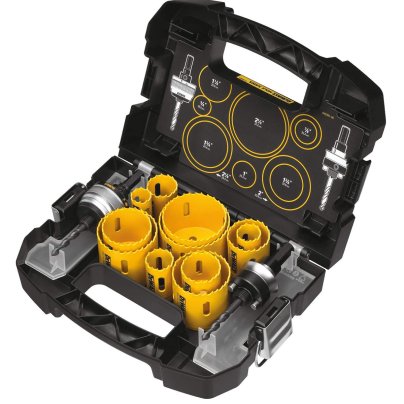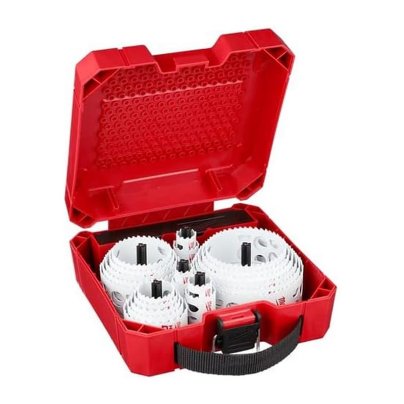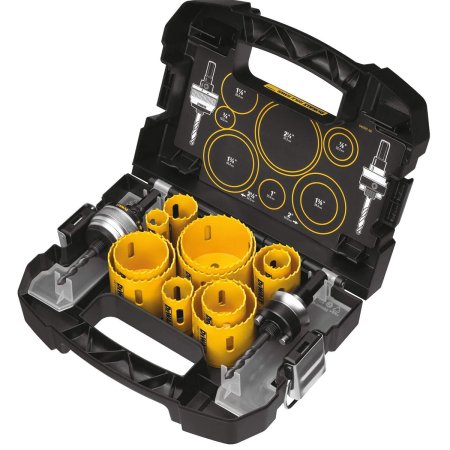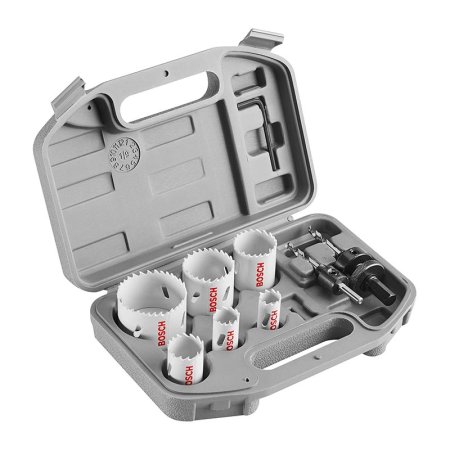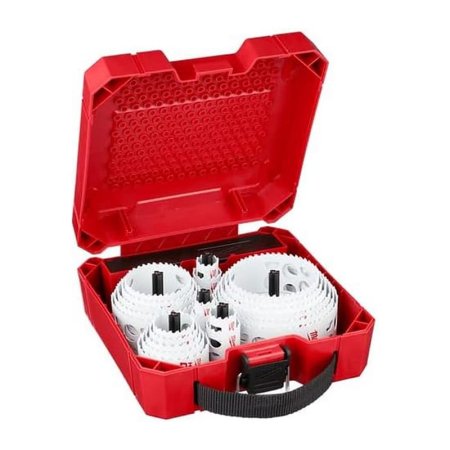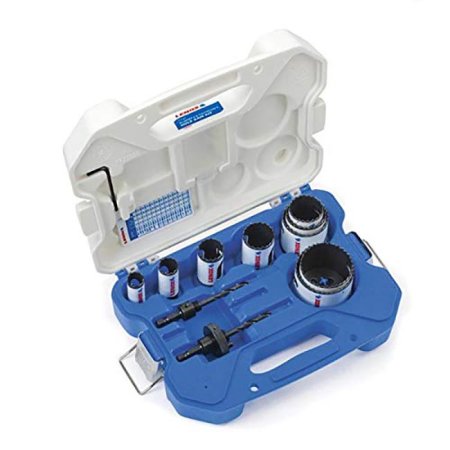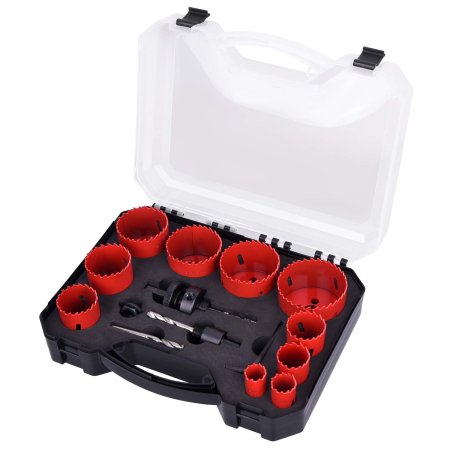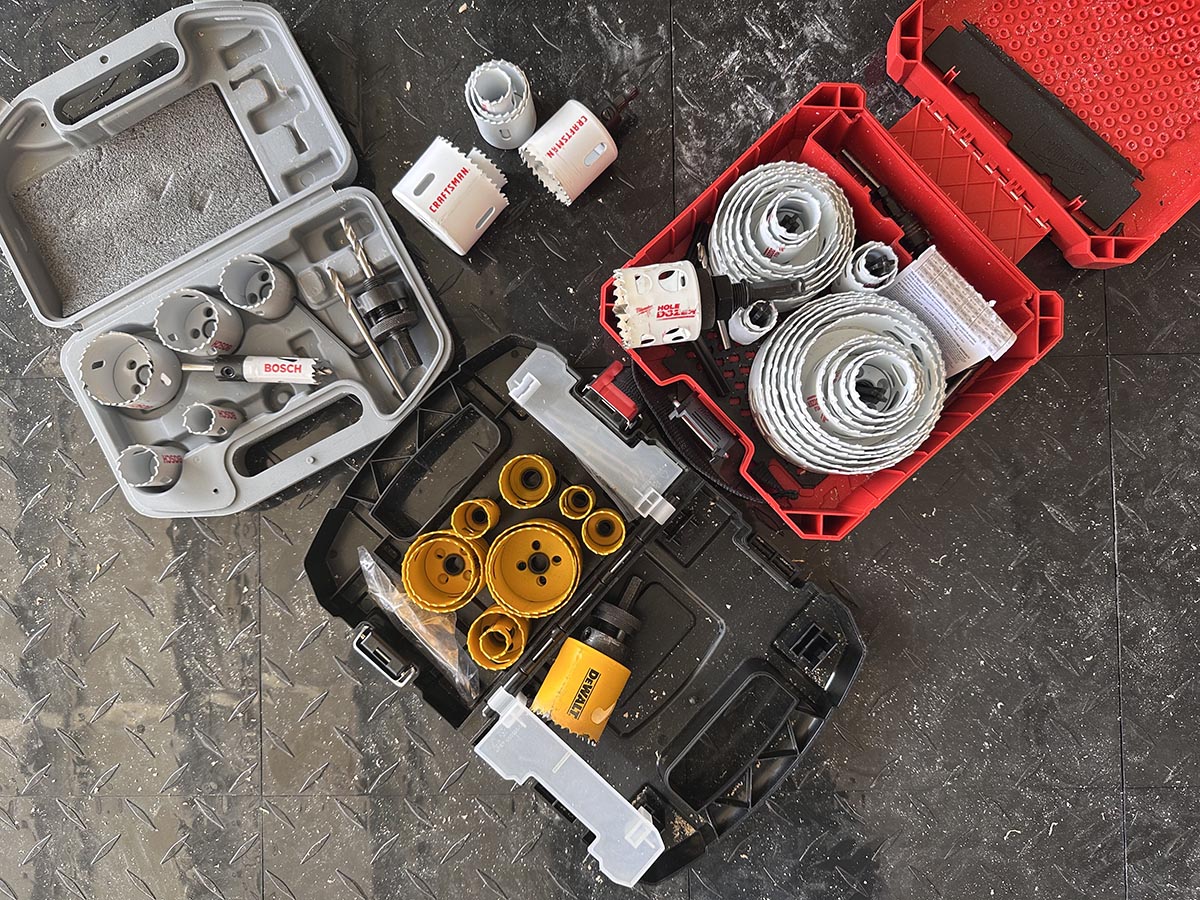
We may earn revenue from the products available on this page and participate in affiliate programs. Learn More ›
Cutting a perfectly round hole in wood, plastic, metal, or even ceramic tile requires a specialized type of cutting tool—the hole saw. A hole saw is a ring-shaped saw blade measuring from less than 1 inch up to 4 inches in diameter and includes a drill bit that attaches to a standard cordless or corded drill.
In an effort to find the top hole saw kit, we put four of the top models to the test, using them to cut through such common materials as wood, metal, plastic, and drywall, and chose the DeWalt Hole Saw Kit as our favorite—but three others made strong impressions, plus we included a few that we didn’t test but can recommend based on the strength of their brand reputation and features. Read on to learn what our tests revealed and to find out more about what to look for when shopping for the best hole saw kit.
- BEST OVERALL: DeWalt 14-Piece Hole Saw Kit
↓ Jump to Review - BEST BANG FOR THE BUCK: Bosch 9-Piece General-Purpose Bi-Metal Hole Saw Kit
↓ Jump to Review - BEST ICE HARDENED: Milwaukee 28-Piece Professional Hole Saw Kit
↓ Jump to Review - BEST DIAMOND: Marsbase Diamond 17-Piece Tile Hole Saw Kit
↓ Jump to Review - BEST DURABILITY: Lenox 13-Piece Bi-Metal Hole Saw Kit
↓ Jump to Review - ALSO CONSIDER: Sungator 18-Piece Bi-Metal Hole Saw Kit
↓ Jump to Review
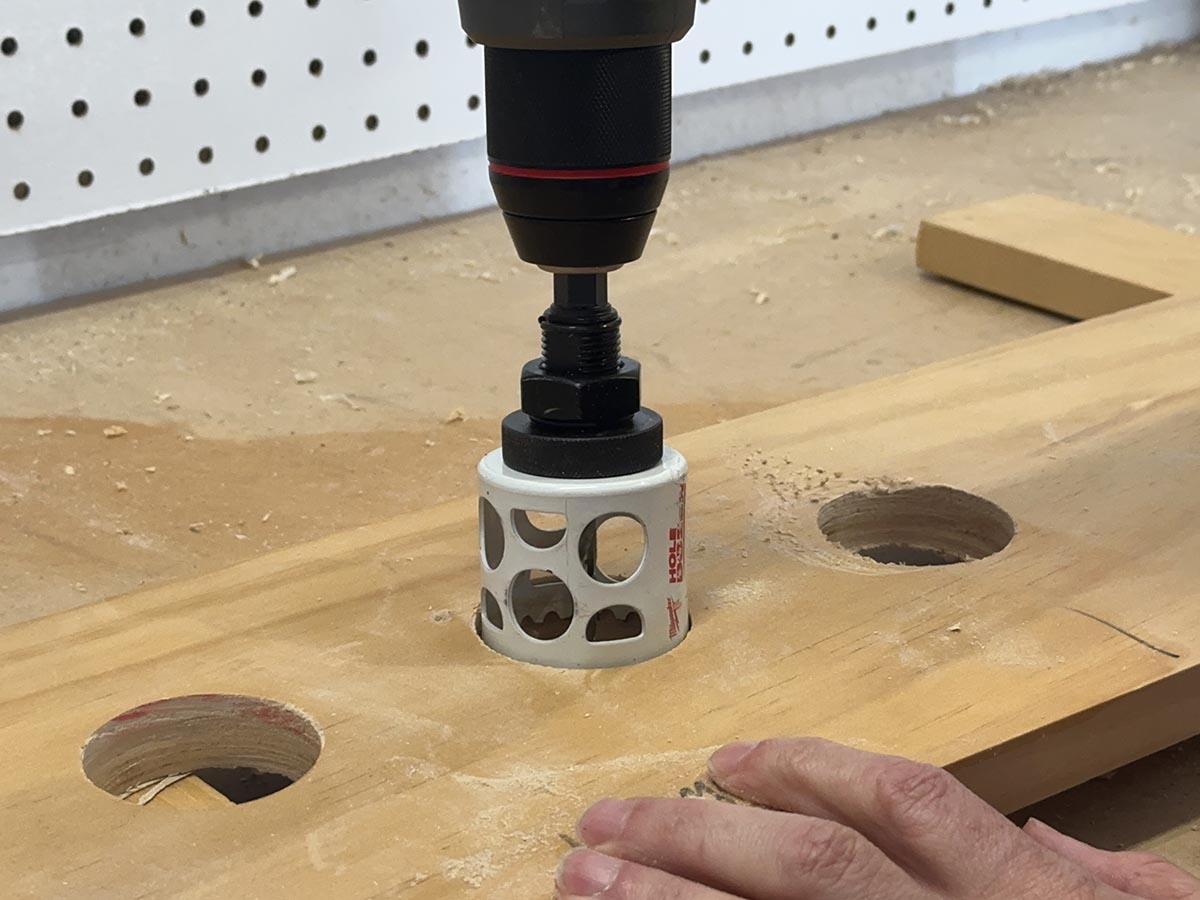
Hole Saw Kits Comparison Chart
| Blade Sizes | Max Cutting Depth | Drill Bits | |
| DeWalt 14-Piece Hole Saw Kit | 11 | 1-7/8 inches | 2 |
| Bosch 9-Piece General-Purpose Bi-Metal Hole Saw Kit | 6 | 1-5/8 inches | 2 |
| Milwaukee 28-Piece Professional Saw Kit | 22 | 1-7/8 inches | 2 |
| Marsbase 17-Piece Diamond Tile Hole Saw Kit | 15 | 1-5/8 inches | N/A |
| Lenox 13-Piece Bi-Metal Hole Saw Kit | 9 | 2 inches | 2 |
| Sungator 18-Piece Bi-Metal Hole Saw Kit | 10 | 2 inches | 4 |
Our Top Picks
This list of top picks below includes hole saw kits made with durable materials in a variety of categories and also covers a broad range of hole saw sizes and prices. Read on to explore some of the best hole saw kits available today to ensure that the next hole is perfectly round.
Best Overall
DeWalt 14-Piece Hole Saw Kit
What We Like
- Deeper blades ideal for thicker material
- High-quality carrying case
- Durable blade quality
What We Don’t Like
- Mandrels can be difficult to work with
Specs
- Blade Sizes: 11
- Max cutting depth: 1 7/8 inches
- Drill bits: 2
Our Ratings: Ease of Use 4.5/5; Performance 4.7/5; Value 4.7/5
We have come to expect quality from DeWalt tool accessories and this hole saw kit is no exception. The high-speed steel blades cut quickly through metal, drywall, and hardwood during testing, thanks to the deep gullets between the teeth that allow for optimal chip removal. The blades also held up well, maintaining their teeth shape and orientation all the way through testing.
The kit includes two mandrels and pilot bits, which are easy to use and securely hold each bit while drilling. DeWalt hole saws are also deeper than the other hole saws we tested, cutting to a depth of 1-7/8 inches, which is handy when working with thicker materials. We also like the long slots that run along the sides of the hole saw that helped make the often-frustrating process of removing wood plugs from the hole saw much easier.
Though not the largest of the kits we tested, DeWalt’s set of hole saws is comprehensive, with 11 blade sizes ranging in size from ¾ inch to 2½ inches. This makes it a great kit for DIYers, plumbers and electricians. We also like the quality of the plastic case, which holes the blades securely and has latch locks to prevent the case from accidentally opening.
What our tester said: “I love the quality and variety of sizes that come with DeWalt’s hole saw kit. The hole saws cut cleanly through any material and the mandrel and arbor make blade changes easy.” —Tony Carrick, Product Reviews tester and writer.
Get the DeWalt hole saw kit at Amazon or Acme Tools.
Best Bang for the Buck
Bosch 9-Piece General-Purpose Bi-Metal Hole Saw Kit
What We Like
- Cuts through materials quickly
- Includes two arbors
- Comes with carrying case
What We Don’t Like
- Limited size options
- Difficult to remove plugs
Specs
- Blade Sizes: 6
- Max cutting depth: 1 5/8 inches
- Drill bits: 2
Our Ratings: Ease of Use 4/5; Performance 5/5; Value 4.7/5
Of all the kits we tested, Bosch’s set of hole saws produced the fastest cutting speeds, burrowing through our ¾- inch piece of hardwood in just 4 seconds, about a second faster than the other hole saws we tested. It also excelled when cutting through metal, drywall, and plastic, producing clean holes with each cut. We also like the arbor system that made attaching each saw to the arbor an easy process. We only wished the saws had larger slots on the side as the small slots made removing plugs a difficult and frustrating process.
While we liked the cutting speed and precision of these hole saws, they did seem to wear a bit more quickly than other hole saws we tested. We noticed some of the teeth beginning to come out of alignment after testing. Bosch’s kit also offers a more limited selection with its six hole saw sizes. The Bosch kit does some with a handy carrying case that keeps all the saw blades and hole saw drill bits together.
What our tester said: “This set of hole saws cut very quickly through any material and comes at a price that’s reasonable for someone who may only use a hole saw every now and then.” —Tony Carrick, Product Reviews tester and writer.
Get the Bosch hole saw kit at Amazon, The Home Depot, or Bosch.
Best Ice Hardened
Milwaukee 28-Piece Professional Hole Saw Kit
What We Like
- Durable build quality
- Easy to remove plugs
- Many hole sizes to choose from
What We Don’t Like
- More than most DIYers need
Specs
- Blade Sizes: 22
- Max cutting depth: 1 7/8 inches
- Drill bits: 2
Our Ratings: Ease of Use 4.5/5; Performance 5/5; Value 4.3/5
Milwaukee’s set of hole saws were outliers in design. The flat shape of the teeth and wide gullets are notably different from the other three hole saw kits we tested. The less aggressive angle of the teeth made it easier to make precise cuts through harder materials. It was particularly adept at cutting through metal, and those wide gullets also allowed it to expel sawdust and speed through our hardwood sample. We also like the many holes on the sides of each hole saw, which made it easier to use a screwdriver to remove the wood plug that was stuck in it after each cut.
These blades go through an ice-hardening process that Milwaukee says is designed to make the hole saw more durable, and it’s not just marketing hype. Milwaukee’s hole saw kit came through testing looking closer to new than any of the other hole saws we tested.
Milwaukee’s kit is also the largest we tested, with 22 hole saw sizes ranging from ¾ inch to a whopping 4¾ inches. All of the kit’s pieces fit nicely into a surprisingly compact molded carrying case. While the size of the kit and quality of the blades make it a great option for carpenters, electricians, and plumbers, it’s probably more than what most DIYers need.
Get the Milwaukee hole saw kit at Amazon, The Home Depot, or Walmart.
More Great Options
In addition to the products that our team tested, we also recommend the hole saw kits below, based on our experience with these tools and extensive research.
Best Diamond
Marsbase 17-Piece Diamond Tile Hole Saw Kit
What We Like
- Arborless design makes bit changes easy
- Includes saw guide for precision cuts
- Broad range of sizes
What We Don’t Like
- Doesn’t come with a carrying case
Specs
- Blade Sizes: 15
- Max cutting depth: 1 5/8 inches
- Drill bits: N/A
Those who need a hole saw kit capable of cutting holes through a granite countertop or ceramic tile, this is the one. This 17-piece kit consists of diamond-tipped hole saws that can burrow through tile, porcelain, marble, granite, and masonry. Each bit has its own shank, so there’s no need to mess with an arbor or a mandrel, making bit changes quick and easy. The kit comes with a saw guide clamp equipped with two suction cups that lock it to the surface of the material. Shaft wheels on the guide hold the drill bit in place for precise cuts. Each bit also has large clearance holes on the side, which allows water to enter to keep the bit cool while also making it easier to remove plugs following cuts. We only wish it came with a carrying case to keep all those bits together and organized.
Get the Marsbase diamond hole saw kit at Amazon.
Best Durability
Lenox 13-Piece Bi-Metal Hole Saw Kit
What We Like
- Staircase style slots make plug removal easy
- Includes two drill bits and two arbors
- Broad range of hole saw sizes
What We Don’t Like
- TK
Specs
- Blade Sizes: 9
- Max cutting depth: 2 inches
- Drill bits: 2
We like the selection of sizes and quality you get with this 13-piece hole saw kit from Lenox. The kit comes with nine sizes ranging from ¾ inch to 2½ inches, covering the most commonly used hole saw sizes. It also includes two drill bits and two arbors, more than typically come with other kits. Long staircase-style slots on the side of each hole provide great leverage points for a screwdriver when removing plugs after cutting. With their 2-inch cutting depth, these hole saws can cut holes in thicker materials than most hole saws. While this kit is pricey for its size, it holds its edge longer than others, making them some of the more durable hole saws out there. All of the kit’s pieces fit into a tough molded carrying case.
Get the Lenox hole saw kit at Amazon or Lowe’s.
Also Consider
Sungator 18-Piece Bi-Metal Hole Saw Kit
What We Like
- Comes with 10 hole saw sizes
- Includes plastic case
- Kit includes three drill bits
What We Don’t Like
- Takes longer to cut through denser materials
Specs
- Blade Sizes: 10
- Max cutting depth: 2 inches
- Drill bits: 4
This hole saw kit from Sungator offers 10 hole saw sizes at an affordable price, making it an excellent budget option for those who need a hole saw for occasional use. The saw sizes range in diameter from ¾ inch to 2½ inches, and the kit also includes two mandrels to accommodate large and small hole saws and one replacement pilot drill bit. These blades can cut to depths of 43 mm (1.7 inches) to 50 mm (2 inches), depending on the bit size.
The manufacturer uses a bimetal construction in its hole saws with a durable carbon body and high-speed steel blades that are rustproof and heat-resistant while making efficient cuts through metal, wood, PVC board, plastic, and drywall. A durable plastic case keeps the pieces of this set neatly organized and ready for transport to the next project or job site.
Get the Sungator hole saw kit at Amazon.
Jump to Our Top Picks
Also Tested
Craftsman 7-Piece Bi-Metal Hole Saw Set
The Craftsman brand has a reputation for making tools and tool accessories that offer good quality at a great price, so we had high hopes for this little hole saw kit. Unfortunately, it has a fatal flaw. Though not the fastest of the bunch, Craftsman’s hole saws cut smoothly through wood, metal, plastic, and drywall, producing evenly cut holes. The problems arose when we attempted to remove the bit from the arbor after using the 2-inch hole saw size. Despite our best attempts to free the bit from the arbor using copious amounts of WD-40 and locking pliers, we (like many people who bought and who reviewed this set online) found it impossible to free it. The problem stems from the arbor, which doesn’t use the same design to prevent the bit from freezing onto the arbor that the other kits we tested use. Given this design flaw, this is not a hole saw kit we recommend.
How We Chose and Tested the Best Hole Saw Kits
We used a mix of research and hands-on testing to make our selections of the best hole saw kits. We put four kits through a series of tests that involved drilling 3/4-inch and 2-inch holes through hardwood, sheet metal, plastic, and 3/4-inch drywall. We timed how quickly each hole saw drill through each different type of material and assessed how cleanly each saw executed cuts. Along with cutting speed, we also assessed how easy it was to change bits and remove plugs from the bit after cutting. Following testing, we evaluated each bit for wear to determine durability.
We selected the four hole saw kits we did not test by comparing specs and customer reviews, using our experience with these tools to help inform our selections. For both tested and untested hole saws, we also considered kit size and price to determine each kit’s value.
| Ease of Use | Performance | Value | |
|---|---|---|---|
| DeWalt 14-Piece Hole Saw Kit | 4.5 | 4.7 | 4.7 |
| Bosch 9-Piece General-Purpose Bi-Metal Hole Saw Kit | 4 | 5 | 4.7 |
| Milwaukee 28-Piece Professional Hole Saw Kit | 4.5 | 5 | 4.3 |
What to Consider When Choosing a Hole Saw Kit
While there are many hole saw kits out there, not all are created equal. These tools can vary in durability and their ability to cut through harder materials, such as hardwood, metal, plastic, tile, and stone. Hole saw kits also vary in price and the number of blade sizes they offer, making some ideal for pros and others suited to DIYers.
To choose the proper hole cutter saw kit, it’s essential to consider such factors as the type of material with which the saw blades are made, the variety of available blade sizes, the number of drill bits included in the kit, the required power source for the hole saw, and the speed with which the hole saw can cut. Read on to learn more about these considerations when shopping for the best hole saw kit.
Blade Material
Hole saws are available in a variety of materials to suit different cutting needs. Most hole cutter drill bits are crafted of high-speed steel, which cuts well while also resisting wear, making them ideal for use as a wood hole saw. Some hole saws are made of two metals: a carbon steel body—which boasts superior durability—and high-speed steel teeth.
Some high-end hole saws are constructed with advanced metals, such as carbon-steel alloy, which is harder than regular steel. Some saw blades go through a process called ice-hardening, which exposes the steel to subzero temperatures. This process helps to harden the steel, making it less susceptible to wear.
Additionally, some hole saws offer blades made with specialized materials. Hole saws with tungsten carbide tips use a harder metal at the tip that makes it an ideal hole saw for metal. Tungsten carbide-tipped saws can cut harder materials such as thick steel, iron, pipe, and stainless steel. Hole saws with diamond-encrusted blades are suitable for cutting holes in hard materials that metal blades can’t cut through, including glass, ceramic, porcelain, slate, tile, fiberglass, and limestone.
Blade Sizes
Hole saw kits include a variety of saw blade diameters to meet a multitude of needs. Blade sizes range from small ¾-inch diameter up to larger diameters of 4¾-inches. Hole saw blades typically include open slots on the side that allow for easy removal of the plug after cutting. Most kits provide at least ten saw blades, along with a set of arbors and mandrels capable of holding the different blade sizes.
Drill Bits
Hole saw kits also include a set of drill bits that function as pilot bits. These bits fit in the center of the round saw blade and serve as a guide that allows the operator to center the blade on the material, essentially a drill bit with hole cutter shell. Many kits include multiple bits so the user has backups should the bit wear down or break.
Power Source
Since hole saw kits work with a power drill, they are either battery- or electric-powered. A battery-powered drill allows for convenient outdoor use where access to a power outlet is limited, while a corded drill provides less convenience but more power.
Since hole saws tend to require significantly more power than a standard drill bit, corded drills present the ideal means for powering these tools, as they produce more torque and higher RPMs than battery-powered drills, in addition to having access to an unlimited source of power.
Speed
Both the style of a saw blade and the material with which it’s made determine how quickly a hole saw can cut. Bimetal blades with high-speed steel are some of the quickest blades.
Blades designed with aggressive teeth angles and deep gullets that can remove more material with each rotation cut more quickly; however, they won’t make as smooth a cut as blades with more teeth and smaller gullets that take longer to cut.
FAQs
If you’re still wondering about how hole saws work, then read on for answers to some of the most frequently asked questions about these tools.
You do not have to use a pilot bit with a hole saw; however, it is challenging to center a hole saw without using a pilot bit as a guide.
A good bimetal hole saw will cut through hard materials, such as thin-gauge steel and stainless steel.
A hole saw will cut through thin-gauge metal materials like aluminum and steel. When possible, use oil or water to lubricate the surface to prevent the bit from overheating, which can damage the bit.
There are a few challenges you’ll face when using a hole saw. First, hole saws require a powerful drill to work properly, which can be an additional expense if you don’t already have one. You also need to be careful and steady when using a hole saw, as they can chip the surface of the material you’re cutting. Hole saws also require more post-cut maintenance. The plug must be removed from the core of the saw blade after each cut, which can be time consuming.
You generally want to run a hole saw at lower speed. Drills produce more torque at lower speeds, making it easier for the hole saw to cut through denser materials. Cutting at a slower speed also prevents the blade from overheating, which can shorten its lifespan.
There are a few things you can do to preserve the blade on your hole saws. Apply a cutting lubricant to the edge before use to help reduce friction. Clean any sawdust or debris out of the teeth after each cut. You can also use a bench grinder with a diamond grinding wheel to clean up the edge of the hole saw between uses.
To remove the plug in a hole saw after a cut, use a screwdriver to pry out the plug through the slats in the side of the hole saw. If that doesn’t work, you can also drill two pilot holes in the plug, then drive screws through the pilot holes to push the plug out.
Meet the Tester
Tony Carrick is a freelance writer specializing in home improvement, landscaping, technology, home security, and design. His articles have been featured on such sites as Popular Mechanics, Futurism, SFGate, Pro Tools Review, and more. Tony has conducted rigorous product testing on everything from power tools to home security systems to backyard grills. With each review, his goal is to help readers determine whether a product meets their needs and if it is or isn’t worth its price tag.
